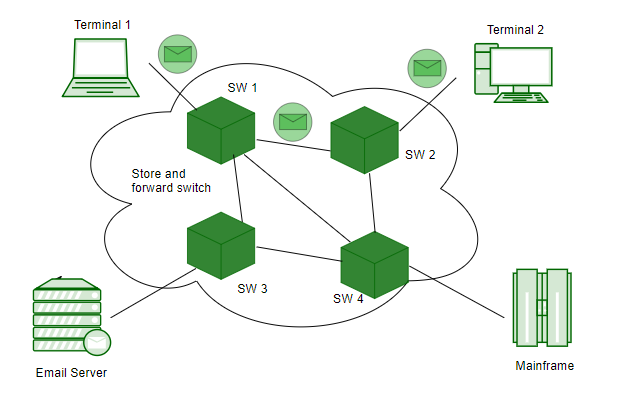Message switching techniques
Last Updated :
20 Jun, 2022
Switched communication networks are those in which data transferred from source to destination is routed between various intermediate nodes. Switching is the technique by which nodes control or switch data to transmit it between specific points on a network. There are 3 common switching techniques:
- Circuit Switching
- Packet Switching
- Message Switching
Message Switching –
Message switching was a technique developed as an alternative to circuit switching before packet switching was introduced. In message switching, end-users communicate by sending and receiving messages that included the entire data to be shared. Messages are the smallest individual unit.
Also, the sender and receiver are not directly connected. There are a number of intermediate nodes that transfer data and ensure that the message reaches its destination. Message switched data networks are hence called hop-by-hop systems.
They provide 2 distinct and important characteristics:
- Store and forward – The intermediate nodes have the responsibility of transferring the entire message to the next node. Hence, each node must have storage capacity. A message will only be delivered if the next hop and the link connecting it are both available, otherwise, it’ll be stored indefinitely. A store-and-forward switch forwards a message only if sufficient resources are available and the next hop is accepting data. This is called the store-and-forward property.
- Message delivery – This implies wrapping the entire information in a single message and transferring it from the source to the destination node. Each message must have a header that contains the message routing information, including the source and destination.
Message switching network consists of transmission links (channels), store-and-forward switch nodes, and end stations as shown in the following picture:

Characteristics of message switching –
Message switching is advantageous as it enables efficient usage of network resources. Also, because of the store-and-forward capability of intermediary nodes, traffic can be efficiently regulated and controlled. Message delivery as one unit, rather than in pieces, is another benefit.
However, message switching has certain disadvantages as well. Since messages are stored indefinitely at each intermediate node, switches require a large storage capacity. Also, these are pretty slow. This is because at each node, first there is a wait till the entire message is received, then it must be stored and transmitted after processing the next node and links to it depending on availability and channel traffic. Hence, message switching cannot be used for real-time or interactive applications like a video conference.
Advantages of Message Switching –
Message switching has the following advantages:
- As message switching is able to store the message for which communication channel is not available, it helps in reducing the traffic congestion in the network.
- In message switching, the data channels are shared by the network devices.
- It makes traffic management efficient by assigning priorities to the messages.
- Because the messages are delivered via a store and forward method, it is possible to include priority in them.
- It allows for infinite message lengths.
- Unlike circuit switching, it does not necessitate the actual connection of source and destination devices.
Disadvantages of Message Switching –
Message switching has the following disadvantages:
- Message switching cannot be used for real-time applications as storing messages causes delay.
- In message switching, the message has to be stored for which every intermediate device in the network requires a large storing capacity.
- Because the system is so intricate, people are frequently unaware of whether or not messages are correctly conveyed. This could cause problems in social relationships.
- The type of message switching does not create a dedicated path between the devices. It is not dependable communication because there is no direct relationship between sender and receiver.
Applications –
The store-and-forward method was implemented in telegraph message switching centres. Today, although many major networks and systems are packet-switched or circuit-switched networks, their delivery processes can be based on message switching. For example, in most electronic mail systems the delivery process is based on message switching, while the network is in fact either circuit-switched or packet-switched.
Like Article
Suggest improvement
Share your thoughts in the comments
Please Login to comment...